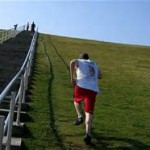Walk/Run Intervals!
Want to start running, but don’t know where or how to begin? Walk/run intervals make the transition manageable. A common mistake is doing too much too soon. Here’s how to progress gradually reducing risk of injury and burnout:
Once you have a regular walking program 3 days a week, begin with 10 second intervals in the middle of your workout. Warm up for 8-10 minutes, perform a series of 10 second jogging or running intervals followed by 30 second or more walking intervals. Conclude your workout with a 5-10 minute cool down. Gradually, add seconds and then minutes to your jogging/running intervals and decrease your walking intervals.
*Consult your physician before performing exercise.
 Subscribe
Subscribe




